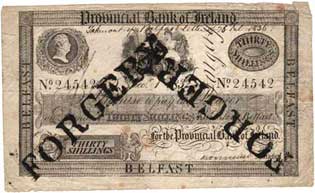
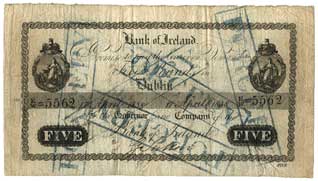

Most early banknotes of the Irish Joint Stock banks were used up and replaced with later issues in the normal course of events.
With the exception of the Provincial Bank of Ireland, where large quantities of cancelled notes are available to the collector, there are very few examples of issued Irish notes available prior to the late Victorian era. Generally, the older the note issue, the fewer examples have survived.
However, contemporary forgeries tended to be retained. These forgeries therefore have a greater interest to the collector than would otherwise be the case. But with a lack of genuine examples for comparison, some of the better instances of these contemporary forgeries may be mistaken by collectors for genuine notes.
Most known contemporary forgeries of early Irish notes are countermarked in some way with the word ‘Forgery’.
A review of the types of forgeries, and a comparison of some of the better contemporary forgeries with examples of genuine notes of the same design can provide pointers on how to distinguish a genuine old note from a contemporary forgery in cases where it is not countermarked, or not clear.
Considering that there can be up to a tenfold differential in numismatic value between a genuine example of an issued uncancelled pre-1900 Irish banknote and a contemporary forgery of it, there is a need for collectors to be able to effectively distinguish between the two.
Currency notes began to gain widespread use in Ireland in the 1700s, after they were first produced during the 1730s as receipts by Goldsmiths and merchants who were custodians of coin on behalf of others (McGowan, P., 1988). The receipts began to change hands as payments rather than the actual coins—thus the receipts became the first currency notes to circulate in Ireland. From this, paper money usage and the business of banking grew, and many small private banks emerged and started to issue banknotes.
For as long as there has been currency there have been forgeries of that currency. Old Irish banknotes are no exception. Banknotes of the Private banks were printed to a good standard on watermarked paper, and would not have been easy to forge. Nevertheless, the earliest surviving examples of contemporary forgeries of Irish banknotes are of notes issued by private banks.
A contemporary forgery of a 30 Shilling note issued by one of the Irish private banks of note issue, Joyce & Blake Galway Bank, dated 4th June 1813 is illustrated in Figure 1. It is a good facsimile of one of the bank's notes.
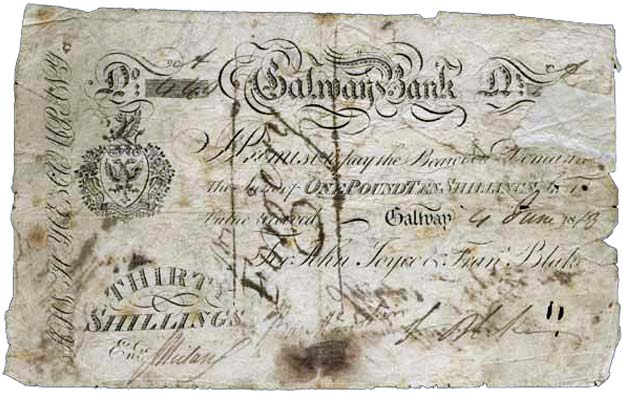
Fig 1. A contemporary forgery of a 30 Shilling note issued by the Irish private bank Joyce & Blake Galway Bank, dated 4th June 1813
With many banks issuing a wide range of notes with lots of varied designs, spotting forgeries would have been somewhat challenging in the 1700s.
In 1783 the first large bank with many shareholders, Bank of Ireland was founded by Royal Charter as a private joint stock bank. This new bank, Ireland’s first joint stock bank, began to produce high quality notes in large quantities. Bank of Ireland notes soon became the reserve currency of the island. The notes also became the target of forgers.
By 1836, the note-issuing private banks in Ireland had been replaced by seven large joint stock banks, with Bank of Ireland being by far the largest of these in terms of capital. Each of the banks issued well-designed banknotes with good security features on good quality water-marked paper. This presented the banknote forgers of the day with more of a challenge than they had faced when copying the banknotes of the private banks.
Pre-1900 issued banknotes of the Joint Stock Banks are quite scarce, those earlier than around 1890 tend to be rarely offered. Older issued notes, from the 1860s or earlier, are very rare and almost all of the surviving examples of the notes of these banks from this era are unissued proofs or contemporary forgeries, and as such are collectible examples of the notes. Additionally, some of these forgeries are quite good copies of the original designs.
One value of contemporary forgeries of early banknotes to today’s collectors and researchers, is that while many of the genuine banknotes of the late 1700s and early 1800s are long-since destroyed, forgeries tended to be retained by banks and other agencies for reference. Some of these made their way into private hands.
Thus, they remain useful examples of banknotes that may otherwise not be available for reference or for collections, preserving detail of the original issued notes, such as dates of issue, designs, serial numbers, denominations used, and sometimes even the names of signatories for a particular issue.
A case in point is a contemporary forgery of a Bank of Ireland £5 note from 1838, pictured in Figure 2. There are no known examples of a Bank of Ireland £5 note of this design in private hands, and this forgery is the only recorded instance of a £5 note of the design. Early contemporary forgeries of a denomination above £1 or 30 Shillings are unusual. Perhaps lower denomination notes would have been more useful to the forgers, likely attracting less scrutiny by the public, and easier to pass.
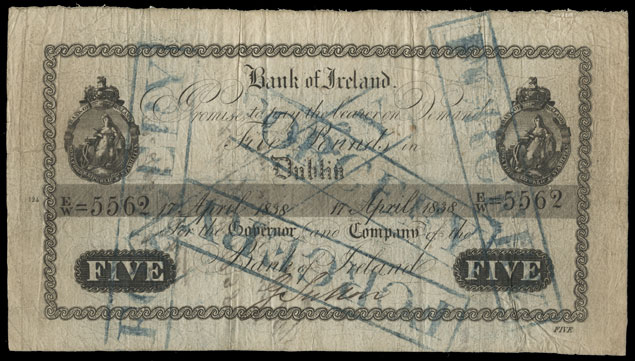
Fig 2. A contemporary forgery of a Bank of Ireland £5 note from 1838. this is the only recorded example of a Five pound note of this design
The various versions of Hibernia on National Bank, Provincial Bank, and Bank of Ireland notes; of the ship and industry on Northern Bank and Ulster Bank notes; and of the intricate coat of arms of the Belfast Banking Company on its notes, were all engraved to the highest levels of unchanging detail, quality and consistency over decades so as to make them very difficult to forge effectively. The consistency of these features also makes them backwards and forwards comparable with any other note of that bank’s issues.
Throughout the life span of a design of a particular banknote elements of the fine detail are constant on genuine notes. These elements vary on forgeries, variations which would have been relatively easy to spot for officials of the bank charged with forgery detection.
Today, however, an unfamiliarity with the notes can make it somewhat more difficult to spot a contemporary forgery of a one hundred and fifty year old or more banknote for which genuine issued examples are rare or unknown.
In the absence of close examination, some of the better forgeries of the earlier notes issued in the first half of the 19th century and before, are sometimes indistinguishable to the modern eye from non-forged notes of the era. Also, in some cases there is a very small pool of available genuine notes to compare the forgeries with, which makes the task of identifying a contemporary forgery more challenging. They can be quite difficult for the collector to spot as being forged notes.
However, in many cases microprinting is present on genuine notes, a feature which is not reproduced well on the contemporary forgeries, and one which can help in present-day identification of these forgeries.
The lack of original notes for comparison can at times make it difficult to identify an early contemporary forgery as a facsimile rather than a real banknote when it has not been countermarked as a forgery.
Many surviving contemporary forgeries are identified as such by having been countermarked with a stamp ‘forgery’ by the bank, as seen in Figure 2, or annotated as a forgery, while many others are quite poorly executed renditions of the design and easily discernible as forgeries.
Contemporary forgeries of the more modern notes, from ca1900 onwards are easier to identify as such, and given that genuine examples of notes of this era are much easier to obtain, the forgeries would have little numismatic value other than being of an academic interest.
The observed examples of post-1920 contemporary forgeries of Irish banknotes tend to be of lesser quality than contemporary forgeries of earlier notes. This might be due to improvements in banknote printing technology far outstripping the technology available to forgers.
Identification of non-countermarked contemporary forgeries can present differing levels of challenge, depending on which bank the note is from, and how early the banknote is. There are instances of contemporary forgeries of early notes being mistaken for genuine notes, and at least one instance of such a note being authenticated, graded and slabbed by a grading company.
Using modern image editing software and high resolution scans of the banknotes it is possible to analyse the design in minute detail. However, if a collector knows what to look for, a magnifying glass is more than sufficient to spot the important differences between a contemporary forgery and a genuine note.
Identifying forgeries of early pre-1838 Bank of Ireland notes can present a significant challenge, as there are very few surviving genuine notes known. There are examples of cancelled notes from this era in the bank’s archives, and these provide a source of banknotes for detailed comparative analysis. On these earlier Bank of Ireland notes, the vignettes of Hibernia serve as the primary high detail design elements which guard against forgery.
A rare example of a genuine Series C Bank of Ireland £1 note in private hands is a £1 note, dated 9 Oct 1819, No. 1861, pictured in Figure 3. This banknote, which has been verified by comparison with similar notes in the Bank of Ireland archives, and the notes in the Bank of Ireland archives provide original instances of the high quality vignette which can be compared to that of other notes of the era that might be suspected of being contemporary forgeries.
This vignette on any note can be compared to those of all Bank of Ireland notes of Series C which use this type of vignette, ca1816 to ca1838, and £20 notes up to 1862. Figure 4 compares the Hibernia vignettes on a genuine Series C Bank of Ireland 30 Shilling note from 1822 with that of a contemporary forgery, also dated in 1822, which has been countermarked ‘FORGERY’.

Fig 3. An example of a genuine Bank of Ireland £1 note, dated 9 Oct 1819
This note is in private hands, and is one of the very few genuine examples of a banknote of this design known outside of the bank’s archives.
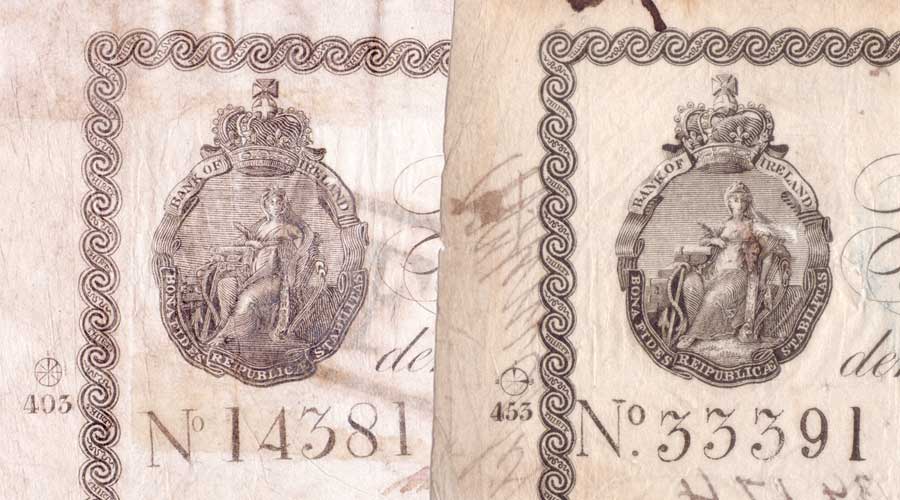
Fig 4. A comparison of the Hibernia vignette on a contemporary forgery (left) of a Series C Bank of Ireland 30 Shilling note from 1822, with that of a genuine note (right), also from 1822
Many of the surviving examples of issued early notes are contemporary forgeries, some of which are very good quality general facsimiles of the originals. Generally, however, forgeries lack the impact of the print quality of genuine notes, and the printing ink may appear pale or faded in comparison to that of a genuine note of the same design type.
Additionally, on closer examination it can be seen that certain elements of the design are lacking on the forgery, being poorly reproduced or scanty in detail. What may make forgeries of the early Irish notes difficult to spot is a current lack of familiarity with the design, born out of a lack of genuine issued notes. However, these forgeries can be identified quite easily in some instances.
It might be expected that the style and size of the serial numbers would be one of the easiest elements of the original to duplicate. Yet, in many cases, the forgery is actually let down by the lack of quality or fidelity of the serial numbers, the reproduction of which in an authentic typeface seems to have presented many forgers with a problem. This is particularly the case with forged Bank of Ireland notes of the 1840s. As the bank printed its notes itself, it is possible that it developed unique numbering equipment, not to be found elsewhere. Reproducing the style of serial numbers on notes of other banks appears to have presented less difficulty to the forgers.
Banknotes from ca1830 onwards had very small printing in the central areas or a high level of fine detail in vignettes and areas of design, or both. On close examination of these finely printed features, it can be seen that they are poorly or crudely copied on forgeries.
The most familiar design of pre-1900 notes of Bank of Ireland is the standardised layout of twin statues of Hibernia and a row of Mercury heads, pictured in Figure 5, which was first produced in 1838. This design remained in use essentially unmodified in its core elements for all denominations until 1921. This makes it feasible to compare a banknote from the 1840s, of which there are very few surviving genuine examples, but several contemporary forgeries, with a genuine One Pound note issued in the period from 1911–1917, which are quite common scarcities.
Although the design did not include microprinting, it relied for security on top quality watermarked paper and high quality printing of a densely engraved design.
The quality of known forgeries varies. One of the better examples of a contemporary forgery is that of a Series E Bank of Ireland £1 note, dated 27 Nov. 1869, number CO 98529, pictured in Figure 5, which is a very good facsimile of the design. It is overlaid on an example of a genuine note, £1 note, dated 15 Dec 1869, prefix CP 38585, which is the next date following on from the forgery. Bank of Ireland notes of this era are rare. These two notes are the only known intact examples of Bank of Ireland notes with three lines of branches in a red gothic typeface.
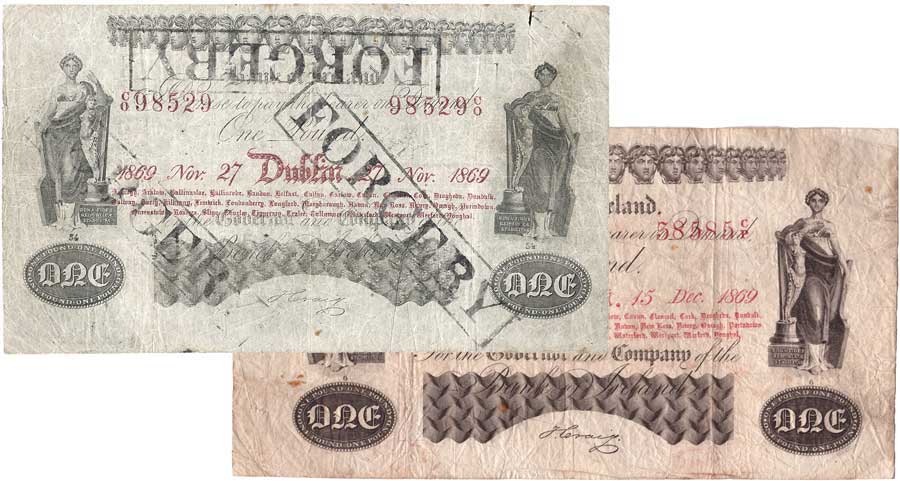
Fig 5. A comparison of one of the better contemporary forgeries of a Bank of Ireland note, a £1 from 1869, with a genuine note of the same era
A detailed comparison of the two notes reveals that some of the finer design elements are inaccurate on the forgery, such as the style of digits on the serial numbers.
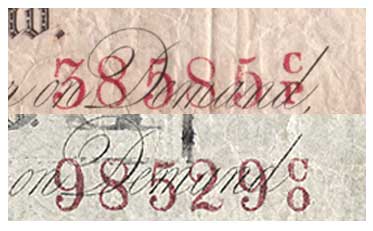
A close up comparison of the serial numbers on the two notes
A close comparison of the serial numbers of the two notes in Figure 5 shows that the typeface of the digits of the serial numbers is inaccurate on the forgery. Both notes have the numerals 8 and 5 in their serial numbers. The style of these digits on two genuine notes would match precisely, they are wrong on the forgery especially in the serif on the 5 and on the letter C of the prefix. Otherwise, the forgery is very true to the genuine note and a good copy. This demonstrates the value of the use of proprietary typefaces and fine detail in the design of banknotes.
By comparing the forgery to a known genuine banknote it can be seen that it is lacking in print quality, and finer elements of the design on the forgery are lacking the detail of the real note. In the absence of a known genuine note for comparison these deficiencies would be challenging to spot on such a good forgery which had not been countermarked. This 1869 forgery could also be effectively compared with later genuine notes of the same core design, up to 1921.
Figure 6 compares two Bank of Ireland £1 note contemporary forgeries of differing quality, dated 5 Dec 1846, and 16 June 1848. More than one instance with the same serial number of each of these notes is known. The overall reproduction of detail in the 1846 note is considerably poorer than that on the 1848 note, notably in the statues of Hibernia, and in the ‘ONE’ protector across the bottom centre.
Figure 7 shows a close up comparison of the detail of a genuine £1 note with that of the two contemporary forgeries in Figure 6. It shows the range of attention to detail on the two forgeries. The 1846 forgery is too poor a rendition of the note to fool a collector, whilst the 1848 £1 note forgery might well pass for a genuine note today in the absence of close examination, had it not been countermarked. This 1848 forgery is one of the better examples seen of a contemporary forgery of a Bank of Ireland note.
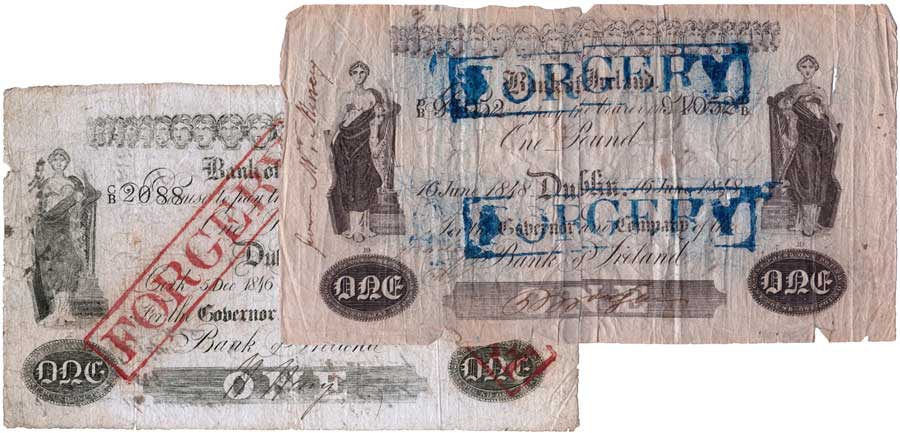
Fig 6. Two contemporary forgeries of Bank of Ireland One Pound notes illustrating the variation in quality between forgeries
Several instances of both notes are known. The note dated 5 Dec 1846 is a poorer rendition of the design than the note dated 16 June 1848, especially in the detail around the two statues of Hibernia.

Fig 7. A comparison of the detail on a genuine Bank of Ireland £1 note, at left, with two contemporary forgeries
One Pound-dated in 1848 in the centre, and One Pound-dated in 1846 on the right. In particular the detail of the text on the base of the harp ‘BONA FIDES REIPUBLICAE STABILITAS’ is lacking on the forgeries.
Having access to an example of a genuine note makes it easier to identify instances of contemporary forgeries of these rare Bank of Ireland notes which may not have been countermarked ‘FORGERY’ and are otherwise of a good enough quality to pass as a genuine note to today’s collectors.
Identification of contemporary forgeries of nineteenth century bank notes of the other six joint stock banks ought to be easier. All of these banks had their banknotes printed by commercial banknote printers, and their designs follow a more or less standard template on most denominations of each bank’s notes.
Other than on Bank of Ireland notes and earlier Agricultural & Commercial Bank of Ireland notes, repeated microprinting of the denomination in words was in use in the centre background on notes of all the banks, except for £50 and £100 notes of the Provincial; £5, £20, £50, and £100 notes of the Belfast Bank; and post-1915 notes of the National Bank. This feature can be cross-compared between notes of different banks to test out a suspected contemporary forgery.
Thus, it is not necessary to be familiar with the design of a banknote, merely to have another note with this common feature present to enable a quick and quite definitive comparative analysis. This is illustrated in Figure 8 which compares the underprint of a Provincial Bank of Ireland forgery of a 30 Shilling note of 1832, and that of an ulster Bank £1 note forgery dated in 1846 with the similar underprint of a genuine note, a Provincial Bank of Ireland £1 note of 1888. No contemporary forgeries have been seen to date of any bank which reproduced this detail in a satisfactory manner, though a few do come close.

Fig 8. A section of the microprinting present in the centre of most denominations of notes produced by all banks except Bank of Ireland
At left is from a genuine £1 note of the Provincial Bank of Ireland from 1888; centre is from a contemporary forgery of a Provincial Bank 30 shilling note, dated 1 Dec 1832; and on the right is from a forgery of an 1846 Ulster Banking Company £1 note. The text is sharp and distinct on the genuine note, indistinct on the forgery in the centre, and somewhat better on the forgery on the right.
Availability of Genuine Issued Notes
The availability of genuine issued notes for comparison varies from bank to bank. In the case of the National Bank issued notes are quite scarce in general, and examples dated prior to ca1900 are rare, whereas proof notes of all eras are very common. Suspected contemporary forgeries like the note pictured in Figure 9 can be compared to proof notes of the same design and era. Post-1870 contemporary forgeries of National notes with all the branches listed can be compared with any National note up to ca1915. Again, the underprint of the denomination in words provides a good security for the note. The underprint on National Bank notes was changed in 1915 to a complex gravure pattern.
There are a lot of proofs from all eras of Provincial Bank of Ireland notes available for comparison; as well as cancelled issued half-notes, many of which have been rejoined by collectors to make examples of the notes. These half-notes enable careful comparison of suspected forgeries with genuine issued notes of the era.
Proof notes of the other three banks, Ulster, Northern, and Belfast are also available. There are few genuine early issued notes known for each of these three banks, and very few contemporary forgeries recorded for the pre-1860 era.
National Bank
There are at least two instances known of a contemporary forgery of a Series B National Bank £10 note, dated 10 Nov 1877: number A06722, pictured in Figure 9, and number A92742 held in the RBS archives. Both of these notes appear to have ben printed from the same plate.
Several other National Bank contemporary forgeries are held in the RBS archives, including four lightly printed £1 notes dated 1 Mar 1871, one numbered H20725, and three instances numbered H20892. Another note in the RBS archive is a rather crude £50 note forgery, dated 25 April 1884, No. 2457, signed by Geo. Gardiner, the same signatory seen on the 1877 £10 note forgeries.
A few contemporary forgeries of Series A National bank notes in the 1860-1866 date regions have also been seen. Although quite good copies of the real notes, they are again let down by a general lack of print quality.
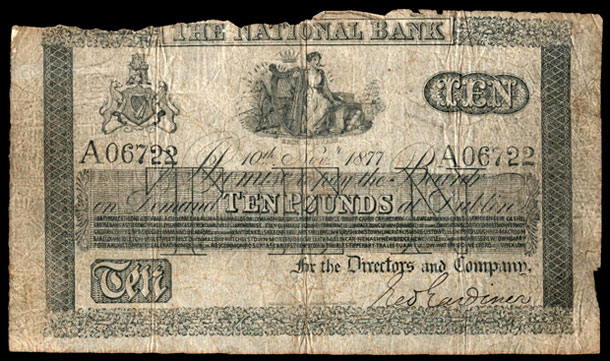
Fig 9. A contemporary forgery of a National Bank £10 note from 1877. Two instances of this forgery with the same serial number are known
Agricultural & Commercial Bank of Ireland
No contemporary forgeries of banknotes from the Agricultural & Commercial Bank of Ireland have been seen.
Although founded as a large multibranch note-issuing joint stock bank in 1835, the bank was beset by troubles and had failed by 1841. Examples of genuine notes of the bank are not rare and are far more common than uncancelled issued notes of any other bank in the 1830s.
Though lacking microprint, the earlier notes are of a good robust design and would have been just as difficult as notes of any other bank for forgers of the day to duplicate. Later design Agricultural & Commercial notes from 1838–1839 included a central underlay in microprinting. No contemporary forgeries of the bank’s notes have been seen.
Ulster Banking Company
There are several instances of contemporary forgeries of Ulster Bank single branch £1 notes dated 6 Oct 1846, with different serial numbers. Some notes are countermarked as forgeries. Examples are pictured in Figure 10.
These forgeries are quite good general likenesses of the genuine notes, and rather better than forgeries of other banks’ notes of the same era. However, on close examination, whilst the finer underprint of the denomination in words is reproduced reasonably well on some of the forgeries, and is one of the better copies of this kind of detail, it is uneven and varies in quality. Elements of the background design, especially the underlying vignette on top also lack detail.
An interesting observation about the Ulster Bank £1 note forgeries of this date is that they were created with at least two different plates. Notes numbered B6699 are the better quality of the two; whilst those numbered B5556 are of slightly lesser quality, especially in the degree of detail in the central microprinting. There may be other forgeries of this date with different numbers.
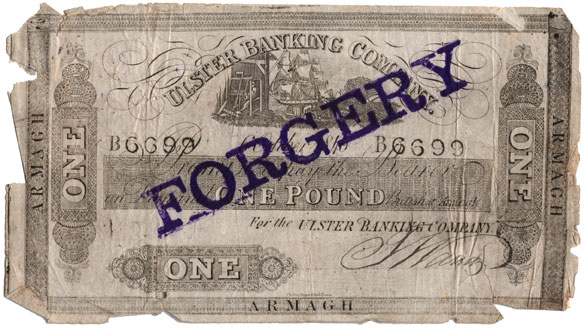

Fig 10. Two instances of Ulster Bank contemporaty forgeries dated 6 Oct 1846
These two notes are examples of better quality contemporary forgeries of a pre-1900 note. Several instances of this forgery with various serial numbers are known.
Northern Banking Company
Figure 11 shows a forgery of a Northern Bank single branch 30 Shilling note from 1830. It is a poorer quality facsimile of the genuine note than that of the Ulster Bank note in Figure 10. This Northern note issue is very rare, and there are no genuine issued examples of the note known.


Fig 11. A contemporary forgery of a Northern Bank 30 Shilling note from 1830. The overall quality of design reproduction of this forgery is poor. A proof of a genuine note is also illustrated for comparison
One of the more well-known contemporary forgeries of a Provincial Bank of Ireland note is that of a single branch Provincial Bank Thirty Shilling note, dated 1 Dec, 1832, No. 24542. There are at least five examples recorded of this forgery, two of which have been countermarked ‘FORGERY’ in large letters, and another three which have not been countermarked. Four of these notes are shown in Figure 12.
One instance of this forgery, illustrated top right in Figure 12, made it all the way to Scotland, and was the subject of contemporary court proceedings at Edinburgh Balie Court in the 1830s. It is now in the Edinburgh City Archives with a note relating that it: '... is a Forgery and was passed this day in the Counting House of Robert Thomas Merchant, Royal Exchange by Margaret Hill, who stated that she received it from Ann Ballantyne - Both in custody'.
It is interesting to note that a forgery of an Irish note would make it to Scotland before being identified as a forgery.
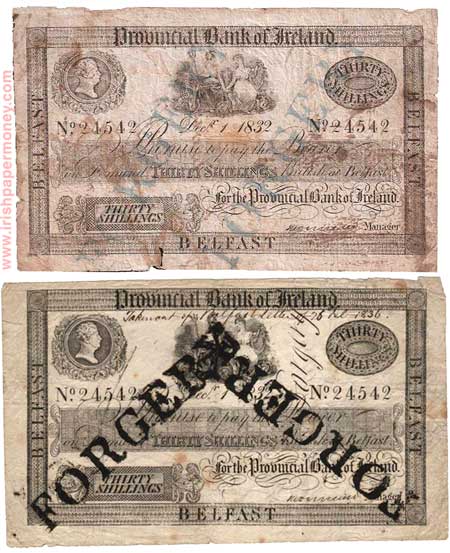
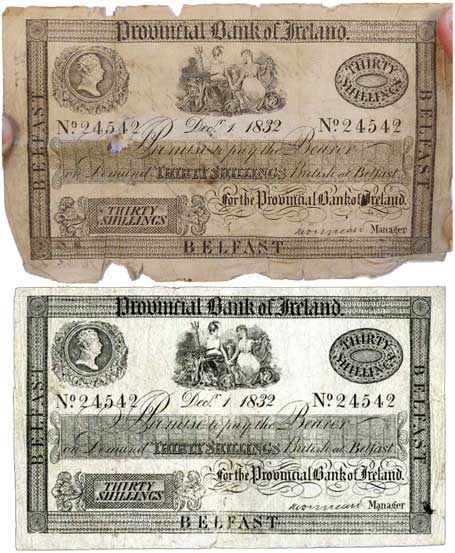
Fig 12. Four instances of a contemporary forgery of a Provincial Bank of Ireland 30 Shilling note, dated 1 Dec 1832, No. 24542
The instance on the top right is in the Edinburgh City Archive, the other three are in private hands.
A fifth instance of this forgery has been certified as a genuine note and encased in a plastic holder by PMG, pictured in Figure 13. This example of the forgery was sold on eBay in April, 2006 for around £1000. It then reappeared again on eBay in March 2007, PMG graded, without its status of a forgery being mentioned by PMG, priced at $3,449 or best offer.

Fig 13. A fifth instance of a contemporary forgery of a Provincial Bank of Ireland 30 Shilling note, dated 1 Dec 1832, No. 24542 has been certified and graded by PMG. This note is in private hands
A section of the reverse of this PMG graded note is pictured in Figure 14. There are two inscriptions on the reverse. First, on top, is a name that looks like George Hill, dated Feb 6, 1835. Below this, in different handwriting, is in small letters, what could be the word ‘Forgery’ above a name, again possibly ‘George Hill’, dated Feb 7, 1835. It is signed ’Peyton Sheals, Chief Constable’. (Mr. Sheals was a constable in Co. Cavan at the time, according to the Irish National Archives). It is possible that Sheals was certifying the note a forgery so that the other named person could get a refund on it.
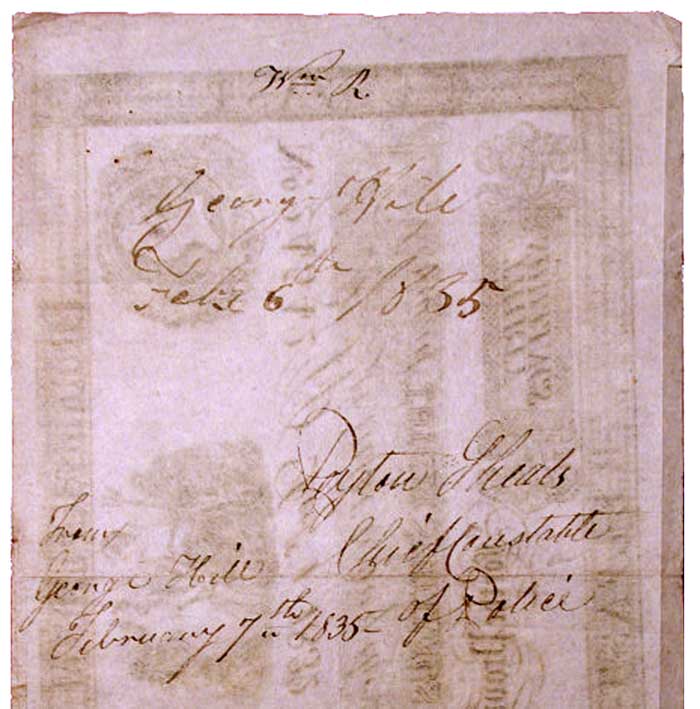
Fig 14. A section of the reverse of the PMG graded note pictured in Fig 14
As an aside, when informed that the note was a contemporary forgery, and provided with images of some of the other forgeries bearing the same number, the dealer who was offering for sale on ebay the note pictured in Figure 15, remarked that it was up to any potential buyer to recover from PMG the difference in value between the note as being genuine and being a forgery, as PMG had graded it. This is a bad attitude for a dealer to have.
The quality of these Provincial Bank of Ireland forgeries is moderately good at first glance. However, the printing on the notes is slightly crooked and uneven in overall appearance. Additionally, fine underprint of the denomination repeated in tiny words is very crude and falls below legibility, as illustrated in Figure 8.
A genuine 1832 Thirty Shilling note from the Provincial Bank of Ireland would have a numismatic value in the order of £3,000 in Fine or better grade, a contemporary forgery would generally have a value of a tenth or so of that.
The fact that a contemporary forgery has been graded by PMG without its being noted as a forgery is a matter of interest, and points to a need for the collector community at large to be able to reliably identify forgeries of these early notes, where an issued intact note can be quite sought-after and valuable, and a contemporary forgery is an interesting space filler, but worth a fraction of the value.
A less common variety of contemporary forgery is one where the forger has attempted to alter the denomination of a banknote rather than reprinting the note. One such Irish banknote has been seen, a Series D Bank of Ireland £1 note, dated 7 Oct 1843 where the forger attempted to alter the denomination to Five Pounds, illustrated in Figure 15. Although the forger would have gone to some considerable work to alter the note, it is unlikely that it would have passed any kind of significant scrutiny, as the serial prefix is that of a £1 note, and in the altered areas of the note the oval ONE protector can still be made out beneath the FIVE, added by the forger.
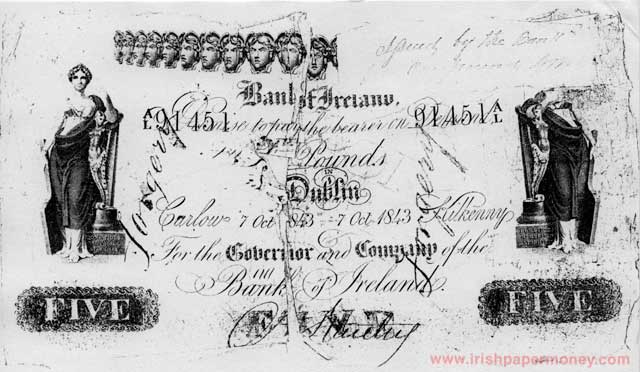
Fig 15. A less common variety of contemporary forgery on which the forger has altered the denomination on a genuine note, from One Pound to Five Pounds
This attempt at forgery is actually a valuable tool for researchers. No examples of a Bank of Ireland £5 note of this design are known. The earliest known £5 note of this general design, Series E, is dated 1 Jan 1845, by which time the bottom portion of the banknote design had been altered, with the creation of a more complex pattern around the denomination in words ‘FIVE’ under the statues.
Interestingly, the only known example of a Five Pound note featuring this design of FIVE protector on the forgery is on a note of an earlier series, dated 17 April 1838, pictured in Figure 2, which is also a contemporary forgery.
The introduction of a new design of banknotes has always created an opportunity for forgers to take advantage of the public’s unfamiliarity with the change in design of currency. This was the case with the introduction of the Euro in Ireland, when local forgers were ready with forgeries of the new currency on day one of its issue in 2002.
Over eighty years earlier, several new designs of banknotes were introduced in Ireland, first with the transition of Irish Currencies after the 1920 Act (Mac Devitt, June 2017), and then again a few years later with the partition of Irish Currencies in 1929 (Mac Devitt, July 2017) and the introduction of the Northern Ireland issue. Contemporary forgeries of these new banknote designs began to appear shortly after their introduction.
From 1920 onwards the banks began to reduce the size of their notes. A number of contemporary forgeries have been seen of these small size One Pound notes. The quality of these varies in terms of how well they are copies of the designs of the originals.
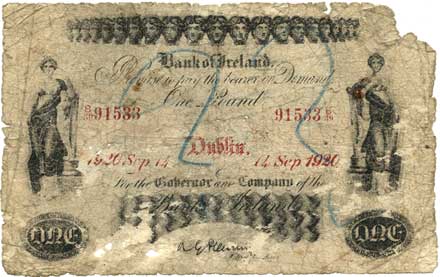

Fig 16. A contemporary forgery of a small size Bank of Ireland One Pound note, dated 14 Sept 1920. Forgeries of other dates in 1920 of this design are also known
The Series G 1920 Bank of Ireland £1 note pictured in Figure 16, although a low grade is quite a good reproduction of £1 note number B39 91533. Figure 17 compares the style of the serial number digits on this note with those of two genuine notes of the era. The style matches very well, and other elements are also well executed on the forgery. Several instances of 91533 have been recorded, as have forgeries with other dates of this £1 note design.
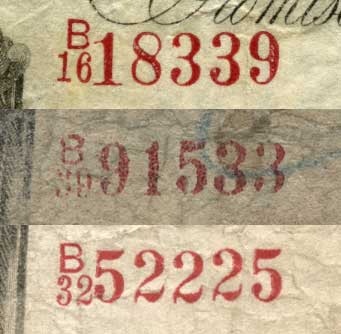
Fig 17. A comparison of serial numbers on the Bank of Ireland forgery, centre, in Fig 16 with the serial numbers on two genuine notes of the same type
By contrast, the Series H Bank of Ireland 1926 £1 note pictured in Figure 18 is a much poorer forgery. This small size design of £1 note was introduced by Bank of Ireland in 1922, and was its first note design to be printed on both sides. The design was revised around 1925 to the configuration of the note pictured in Figure 18, when the serial numbers were changed from black to red.
Considering that notes of this design revision had likely been in circulation for at least a year by the time that the illustrated forgery was produced, the quality of the forgery is very poor indeed, and is unlikely to have been a very convincing copy of the note.
Additionally, the forgery uses the wrong prefix, A18, which was used on genuine One Pound notes dated 18 July 1925.


Fig 18. A poor forgery of a Bank of Ireland One Pound note, dated 29 Jan 1926, along with a genuine note of the same date for comparison. The date is mid-way through the series
The Series C Ulster Bank £1 notes, a new note issue first produced in 1921, were small size and printed uniface. Figure 19 shows a well circulated forgery of the new design, bearing the first date, 1 Dec 1921, along with a well circulated genuine note of the same date for comparison. The forgery is a good general copy of the design but lacking in the steadiness and accuracy of its detail. The microprinting in the central area is poorly printed on the forgery, as is usual with microprinting on contemporary forgeries of the notes of the joint stock banks.
The Ulster Bank £1 note would have been easier to create an effective forgery of than the 1926 Bank of Ireland £1 note. It is likely that forgeries of the post-1920 era banknotes of other banks were made, and have survived also.
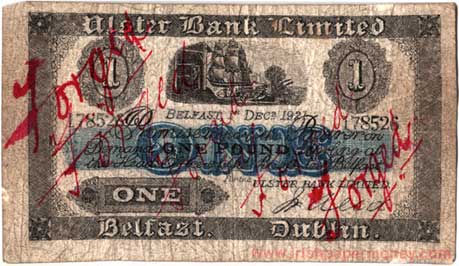
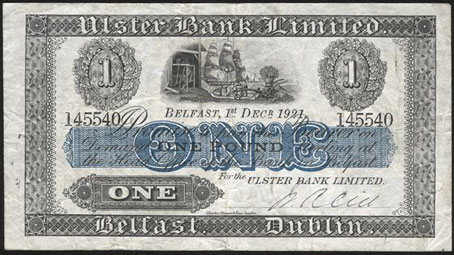
Fig 19. Ulster Bank introduced new small size notes in the early 1920s. Illustrated is a circulated forgery of a One Pound note bearing the first date, 1 Dec 1921, along with a well circulated genuine note of the same date for comparison
The National Bank introduced an entirely new design of banknotes for its 1929 Northern Ireland Issue which entered circulation on 6 May 1929. In the early 1930s forgeries of the new £1 notes appeared in Belfast.
Twelve examples of these, all dated 6 May 1929 are held in the RBS archive, along with a record of when the notes were acquired by the National Bank. Five of these were reported at different banks in Belfast in Northern Ireland on 17 February 1930, a sixth on 20 February 1930, including three instances numbered 031609. One of these six, which was presented to a Northern Bank branch was handed back to their customer, who retained it, and it was not obtained by the National Bank.
Four more forgeries trickled into banks in Belfast, and a fifth in Waterford in the following year up to February 1931. Another forgery numbered 031609 was then handed in on 9 February 1932 in Belfast; and on 15 November 1935 a forged note was handed into a branch of Barclays Bank in Newcastle upon Tyne. This forgery is numbered 403230, and is recorded as having been retained by a businessman as a curio.
Several Forgers at work
From an examination of the notes, it would appear that several agencies were forging them. The quality of these forgeries is mediocre overall.
The forgers seem to have struggled with the reproduction of the main design elements of the notes especially the green gravure underprint in the bottom centre of the notes, demonstrating the robustness of the new design in security terms. All the forgers' attempts at reproduction of the main bank title and of the bank’s coat of arms of two hounds on either side of a shield bearing a harp were crude. The reproduction of this coat of arms was better in some earlier pre-1900 contemporary forgeries. The poorest forgery seen appears to be little more than a drawing.
One group of these forgeries have serial numbers (403230, 408230) in a typeface which is far too large, and happens to fall well outside the number range for the 6 May 1929 date, which ran to 150,000 notes according to the bank’s note registers (as cited by PMI, 2009, p223).
In common with other observed contemporary forgeries, there are several instances of notes bearing the same serial number, with four instances each of 031609 and three instances of 049583.
Examples of contemporary forgeries of old notes of the joint stock banks are occasionally offered. No contemporary forgeries of Currency Commission Consolidated Bank Notes have been seen as yet, nor have there been any recorded instances of forgeries of Legal Tender Notes prior to the 1970s. It would be interesting to see how well the designs of these banknotes would have been copied by the forgers of the day.
Original Version (2018)
Original [print] version (2021), published in two parts in Coin News as: 'Contemporary Forgeries of Early Irish Banknotes c.1800-1930', January 2021, p80; February 2021, p72.
References
Bank of Ireland Archives, Dublin.
Blake, R., Callaway, J. (2009). Paper Money of Ireland, 1st Ed.
Central Bank of Ireland Archives, Dublin.
Mac Devitt, M. (2005). Irish Banknotes. Irish Paper Money 1783–2001, 3rd Ed.
Mac Devitt, M. (2017). 'The Transition of Irish Currencies, Irish banknotes 1918–1928', Coin News, June 2017, p.77.
Mac Devitt, M. (2017). 'The Partition of Irish currencies, Irish banknotes 1928–1930' Coin News, July 2017, p.85.
Edinburgh City Archives, as cited by https://web.archive.org/web/20170321040820/http://lothianlives.org.uk/edinburghs-top-12-bailie-court-processes/
McGowan, P. (1988). Money and banking in Ireland - origins development and future. Journal of the Statistical & Social Inquiry Society of Ireland, Vol. XXVI, Pt. I, 1988/1989, pp45-137.
National Archives of Ireland
Royal Bank of Scotland Archives, Edinburgh.
Noonans, Mayfair for some of the images.
The Transition of Irish Currency, Irish banknotes 1918–1928
The Partition of Irish Currency, Irish banknotes 1928–1930
Banknote Design Evolution 1824 to 1916
Irish Three Pound Notes
Contemporary Forgeries of Early Irish Banknotes, ca1800-1930
Limerick Soviet Notes
Irish World War 2 Banknote Issues
A Series Irish Ten Shilling Notes
B Series 100 Pound Note
Low Number Irish Banknotes
Irish Joint Stock Banks of Note Issue from 1783
Irish Legal Tender Note Specimens
Ploughman Scan Survey (PSS)
![]()